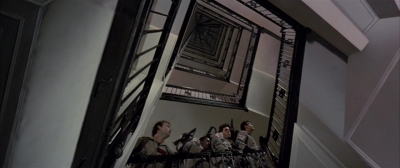
This is the only reason Ghostbusters gets away with the self-indulging previous scene. The ghostbusters show up like badasses. Cut to them crawling up the stairs like a couple of pansies.
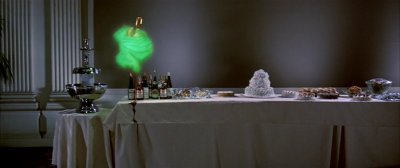
I love the attention to detail such as giving the ghosts their own personality like this little green glutton here. Notice the wine going right through him.

When the first movie opens the door to a God’s realm, where exactly do you go that could possibly be satisfying in the sequel?
Review by Jay Wilson Born in 1980, Ghostbusters has been a part of my life pretty much as far back as I can remember. I grew up with this movie. And often times when we, as adults, revisit something from our childhood, we find the magic that so fascinated us once upon a time has left. For me, though, Ghostbusters hasn’t lost that magic ... ...it's gotten better. I’ve always grinned, giggled, and laughed at the famous lines such as “We came! We saw! We kicked its ass!”, at that famous silent moment after Peter Venkman (Bill Murray) yells at Gozer “we didn’t choose anything!” then they all look at Ray Stantz (Dan Aykroyd) who is quietly backing away, and the sight gags such as the dream sequence where a beautiful apparition appears floating above one of the ghostbusters then disappears and unzips his pants. But I never really noticed how Ghostbusters effortlessly, nimbly, and miraculously juggles horror, action blockbuster, drama, and comedy—how it’s paradoxically an intimate story about a handful of characters trying to make a living in New York while simultaneously an end-of-the-world epic battle. Just listen to the Ray Parker Jr song. It’s unforgivably cheesy blatantly pandering, dare I say even stupid? ... and somehow freaking awesome. I dunno how they made this oddball impossible cocktail of genres, tones, and styles work, but damn it, they did. Many comedies—even so-called ‘edgy’ or ‘racy’ comedies—tend to overindulge in parody so that when they tackle an adult subject such as sex, they’re really tackling a goofy bastardization that might as well be a cartoon. It’s as if comedy is timid about embracing serious subjects which frustrates me to no end. But Ghostbusters knows it can get away with occasionally venturing away from comedy entirely and playing key scenes straight for the sake of its story; then in other cases it knows it can make very slight strategic exaggerations to get to the laughs, resulting in a mature scene that’s also funny. 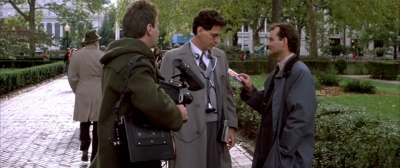
I’ve always liked this little exchange even though it doesn’t really add anything to the story. It’s a nice little character touch that underlines how underneath Venkeman’s smartass attitude, there is a genuine friend in there too.
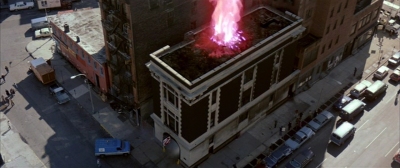
Ghostbusters not only gives us a memorable pink explosion, not only follows it up with the wicked-looking geyser of ghosts, but it actually uses said explosion for narrative purposes.
The movie opens with a nice looking librarian taking some books down to the basement. As she walks through the narrow aisles, books levitate from one shelf to another behind her. Eerie. She continues on, and then the card catalogs open on their own and cards fly out. Suspenseful. She panics and runs as the camera tracks her through that daunting maze of towering bookcases. Pretty intense. The only part of this sequence—one shot—that is not quite played straight is the finale where she makes a wrong turn and runs into the (off screen) ghost and screams: a wind machine blows her hair and clothing while various light effects dance off her to create the illusion that something is happening even though nothing really is happening. Suspenseful build up, intense escalation, and safe comedic release. Later on, there’s a great shot where one of the ghostbusters’ quasi-love interest, Dana Barrett (Sigourney Weaver), comes home from the gym and answers the phone. And while she talks, she starts to slip out of her workout clothes ... and the camera slowly pans around her. It starts harmlessly enough, but as the camera changes position we see a doorway come into view with ominous lights peeking out of the cracks. We know something lurks, but she does not ... yet. Dana hangs up and slowly looks over to see something trying to reach through the door—twisting and warping the wood. Then we’re treated to a legitimate horror movie jump scare as monstrous arms tear through her chair and hold her down. The chair spins, the door flies open, and that is not a goofy monster waiting for her. Speaking of great shots, there’s one at a party thrown by Lewis Tully (Rick Moranis). The camera follows him as he goes all around the room for a little over a minute—getting asprin for one guest, talking about the deal he got on the food with another guest, dancing with yet another guest, and finally welcoming a new set of guests in the door—all done in one continuous take. Amazing in its own right, but factor in too that Lewis Tully is a side character whose pathetic geekiness is unmatched in all cinema. Listen to the painfully accountant-ish number-crunching-obsessive dialogue (which somehow is hilarious by being overly detailed and boring) and watch Rick Moranis’ perfect flat delivery of a one note, socially uncomfortable, boring guy trying desperately to have more than one note and, you know, a life or friends or ... please don’t leave me. Virtuoso comedy and virtuoso execution. 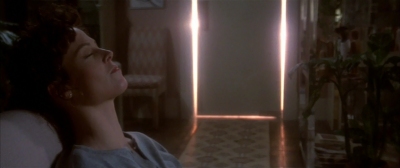
This frame effectively communicates Dana’s vulnerability and the lurking danger on its own, but it’s even cooler in motion.

... but it also clearly establishes the geography and spacial relationship between the characters and the paranormal phenomena.

I love how this building becomes a character in and of itself which somehow manages to play a pivotal role in the story. Yes, a building.
And I love how Ghostbusters works on two levels simultaneously—a PG level that even children can appreciate and respond to, while at the same time suggesting R rated material and entertain adults without showing anything. For example, a major plot point of the film revolves around the “key master” (Moranis) and “gatekeeper” (Weaver) finding one another. Sexual innuendo? You bet. The scene where they meet, they approach each other like an other-worldly love at first sight moment. And as they come together, they embrace in a parody of the famous “Kissing Nurse” photograph taken at the close of World War II. Even before my familiarity with the iconic Alfred Eisenstaedt image, the scene was still funny seeing the role reversal of a taller Weaver leaning the shorter Moranis back to kiss him. The next time we see them, they’re lying on a bench—Sigourney Weaver stretched out exotically and Rick Moranis conked out as if hit by a train. And watch them as they get up with Weaver gracefully slithering off the bench and Moranis sitting up with his glasses and hair messed up, punch-drunk with euphoria. As adults, we know the full extent of what happened between them, but the sheer contrast of these two persons alone provides enough comic imagery for kids to get a laugh. Of course, a movie called “Ghostbusters” has to deliver on its premise of people facing down ghosts, resulting in a special effects extravaganza. Because of the expensive price tag on special effects, some films (especially lowly comedies) tend to isolate the effects and as a result it never feels truly integrated with the rest of the world and thus doesn’t feel like a part of the film’s universe. But watch any scene requiring a ghost. The makers are careful to include at least one shot where both a major character is in the frame too. Take for example: the Ghostbuster’s first call when they catch the little green ghost (later named Slimer). The scene’s climax is done in wide shot with the ghost at the ceiling, Venkman and Egon Spengler (Harold Ramis) are on either side of the screen firing confinement beams to keep the ghost in place while Ray coordinates their efforts and prepares the trap. All in frame. All at the same time. Not every effects shot has a principle actor, of course, but enough do so that when they do cut to a ghost by himself it feels like a narrative decision—like the ghosts are characters, themselves, and get no special treatment. When it’s appropriate to cut to just a ghost, they cut to just a ghost. When they need to establish the distance between Venkeman and the ghost that slimes him, we see both in frame together. 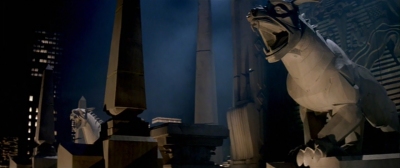
Seriously, how many movies really use architecture and sculptures prominently and effectively to not only create visually appealing compositions, but also tell a unique and compelling story?
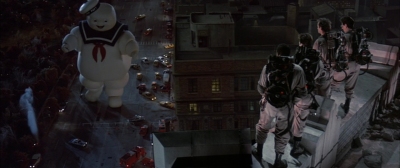
This is such a great shot. Well composed, wonderful intergration of live action and effects. It establishes the character’s position to the marshmellow man, and it communicates Mr. Stay Puft’s size.
And despite being flashy spectacle, Ghostbusters never gets carried away with its effects. They come naturally from the story. Midway through the film, for example, their headquarters blows up. But much earlier in the film, before the trio form the Ghostbusters, Egon mentions the possibility of trapping and containing a ghost. Later we see the Ghostbusters catch a ghost, but we don’t see what they do with it. Eventually, the team hires a new recruit (Winston Zeddmore played by Ernie Hudson) and Ray shows him the proper procedure for unloading the trap into the containment system which involves a lengthy and meticulous series of pulling levers, docking devices, pushing buttons, and flipping switches (which incidentally, gives it a sense of verisimilitude despite being utterly ridiculous). Then kicking off the third act, the EPA (which itself has been threaded into the narrative in a previous scene) shows up and abruptly shuts down the containment system. So when a fireball bursts through the roof of the Ghostbusters headquarters and a geyser of ghosts fly up into the sky, it’s not just another shiny thing that goes boom. We’re right there with the Ghostbusters saying “oh shit” while at the same time thinking, “wow, that looks cool.” I could go on and on about Ghostbusters. It’s one of the few movies that, while watching, I realized I had absolutely no major complaints. When I really think about it, I can come up with some nitpicks—there’s an effects shot of Slimer when we first see him in the ball room that’s not up to par, the “cross the streams” setup line is pretty clumsily inserted—but, seriously, I wish a tenth of the movies I watched had the kinds of problems Ghostbusters has. No movie is absolutely perfect, but Ghostbusters comes pretty damn close. | ||||||||||||||||||||
|
| ||||||||||||||||||||
